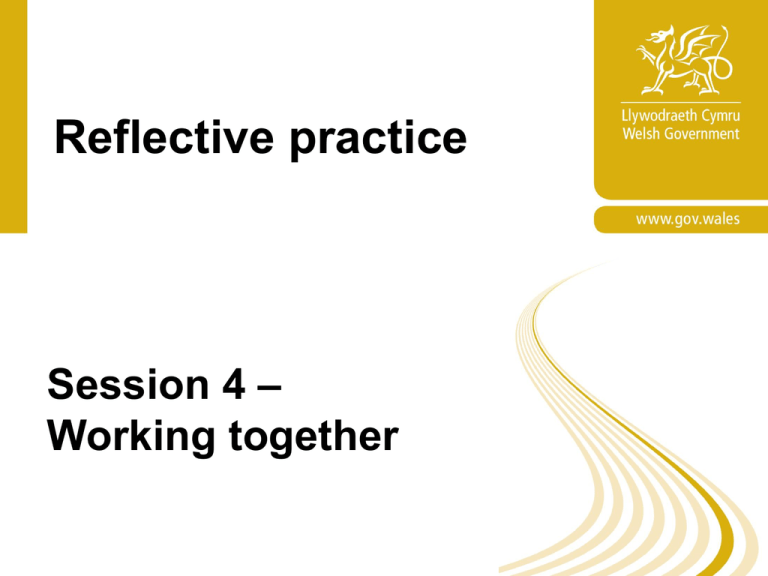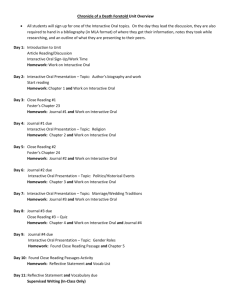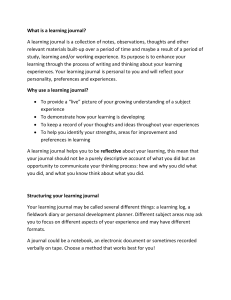Session 4 - Learning Wales
advertisement

Reflective practice Session 4 – Working together Introduction • Welcome to the fourth and final session on reflective practice. • In this session we are going to be exploring reflective practice as a collaborative activity and planning for a shared approach. • You will be invited to set up a group reflective practice event as described in this session, but if this is not possible you can still take part in the activity from an individual stance. Collaborative reflective practice • There are no rules that say reflective practice should happen on an individual basis. Discussion and sharing of ideas and practices often results in enhanced understanding and new approaches to learning and teaching. • In this session, we are going to develop an understanding of one such approach – lesson study – and develop too the skills of observation that are so important to this approach. • ‘Lesson study is a system for building and sharing practitioner knowledge that involves teachers in learning from colleagues as they research, plan, teach, observe, and discuss a classroom lesson.’ (Lewis, Perry and Friedkin, 2009:142). What is ‘lesson study’? Activity 1 Watch this short video and use the learning journal to make notes of points that are of particular interest. www.youtube.com/watch?v=nV35Nr0DKFs&list=PL8F2DC1 E5AE07092F&index=5 Professor John Elliott has been in the vanguard of lesson study research. He writes about some of his research in the following paper. www.leeds.ac.uk/educol/documents/184206.pdf Setting up a lesson study • The basis for any lesson study is observation. This foundation skill allows you to build a deeper understanding of the relationship between learning and teaching, and to analyse how to make this most effective. • Lesson study synergises the impact by drawing together a number of observations on the same classroom events, which are then analysed and discussed. • We are going to begin by planning a lesson study and then developing enhanced observation skills. Planning a lesson study • Problematise the focus – what is it that you want to understand and know more about? • Be specific – if the focus is too wide you will not be able to collect the data. • You have already had some experience of this from Session 2. Don’t try to observe the unobservable. ‘Is this student learning?’ cannot be answered by observation. However, ‘Is this student engaging with the teacher and offering positive answers?’ is observable, therefore be clear about what it is you want to know. Observing what might seem to be a small spectrum of classroom behaviour is more productive than trying to observe too much and being superficial in your results. Stages of lesson study • Plan using five stages. 1. Explore some of the existing information about your focus. 2. Undertake the observation lessons. 3. Discuss and analyse post observation. 4. Develop learning and teaching using the data you have gained. 5. Disseminate your findings. • If you are working with colleagues, identify the others in the group – triads are a popular approach. Make sure you all have time to meet and plan your observations together. Stage 1: Finding out • Part of lesson study is to enhance your knowledge of the field. • This does not mean long sessions in a library but rather taking time to check websites (look at Learning Wales, for example, for a wide range of information and links), investigate professional journals, talk to colleagues. • Gather information so that you begin the lesson study informed and aware of how you might collect relevant data. Stage 2: Observe the lesson • Although teachers observe students every day in the classroom, for the purposes of lesson study, observation has some specific skills, and ways of recording information. • The following article explores reasons why we might need to use different approaches. www.cem.org/blog/414 • There are two major ways of observing – collecting data using structured observation and collecting data using unstructured observation. We’ll look at both in the following slides. Structured observation • This involves using a prepared lesson grid, usually timed so you observe every few minutes – you look and record every 5–10 minutes. The facilitator’s pack has an example for you to use or develop. • Observation needs to focus on something specific. General ‘what’s happening’ is diffuse and will not tell you much. Instead choose key events or key students to observe. Structured observation (continued) • The prepared grid asks you to identify some key behaviours you are interested in tracking. • Use the grid to record when these happen. You should not record any other behaviour as you are only focusing on the one event you have identified, and the sub-categories that you have identifying as making up that behaviour. You might, for example, want to know whether a student responds in particular ways to a specific context. • The result will be a detailed pattern of behaviour so this approach is very useful if you want to know about particular students’ activities. Unstructured observation • This has the same starting point as unstructured observation – a clear focus, and particular behaviours you want to know about. • However, recording is more of a continuous approach. Instead of checking behaviours every (say) three minutes, you record those behaviours as and when you see them happening. • An example record sheet is available from the facilitator’s pack. • This way of observing is very useful if you want a more narrative way of recording what is happening in the classroom, as the result will be a ‘storyline’. • There is no one correct way – choose whichever best fits the purpose of your observations. Stage 3: Analysing the data • Once you have collected your observations, it’s tempting to write up your impressions so far, rather than analysing the data. • However, and particularly if there are three sets of results, it is important to analyse – really mine – the data. • Go back to your original questions. – How have the data illuminated some of the questions? – What has it demonstrated? – Are there themes emerging? – Are there contextual events? Time of day? Types of subjects? • Look for patterns in the behaviours you have noted. Observation in action Activity 2 Watch this 10-minute video that shows a teacher working with a primary class. The area to consider is the teacher’s use of questions. www.youtube.com/watch?v=tAz7TD02ytU Now using either structured or unstructured observations, what can you say about this teacher’s use of questions in the classroom? Further helpful information is available in the following links. www.nae.edu/File.aspx?id=14350 http://archive.teachfind.com/ttv/www.teachers.tv/videos/hotresearch-questions.html What did you find out? • There are a number of ways to think about the work of this clearly successful classroom practitioner. • However, using the readings, we might ask did the teacher: – use wait time successfully? – positive acknowledgement? – feedback that encouraged deep thinking? – did everyone participate? • Your data analysis should allow you to see strengths and limitations in classroom performances. Stage 4: Developing learning and teaching Activity 3 Using the sample video of the teacher and questioning, what, from your observations, would you advise about: • the strengths of her use of questioning • how she might develop her use of questioning. If you are working in a group, please discuss the questions together. This approach is exactly the same as you would use to discover how your own observations might lead to improved learning and teaching. Stage 5: Dissemination • David Hargreaves talks about ‘sticky knowledge’ – that is, the knowledge teachers have but never get to share, often because of lack of opportunity. Part of reflective practice is making those opportunities to share new knowledge. • This might be simply through describing your research in a staff meeting. You might write it up for a school newsletter. You could make a poster presentation which is left for others to read at their convenience. • The imperative for reflective practice is – please, don’t keep good practice to yourself. Summary • These sessions have: – introduced you to the principles and practices of reflective practice – demonstrated how reflective and reflexive practice are linked to teacher research – developed both individual and collaborative reflective practice. • Putting what you have learned to use will enable you to develop learning and teaching in focused and precise ways. • Reflective practice is about developing an informed, professional voice. • We hope these sessions have supported you in that.








